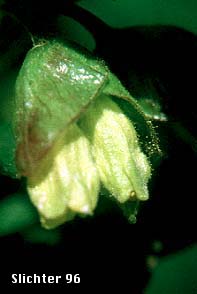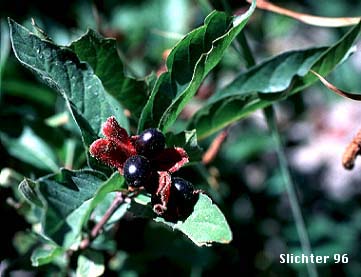

 Characteristics:
Characteristics:
Black twinberry is also known as bearberry honeysuckle. It is an erect shrub with many stems from 0.5-4 meters high. The stems are four-angled and yellowish to grayish-brown in color. The older bark may appear shredded. The leaves are opposite on the stems and are elliptic, elliptic-oblong, elliptic-ovate or elliptic-obovate in shape, narrowing gradually to a pointed tip, or sometimes narrowed abruptly to a point. Individual leaves range from 5-14 cm long and 2-8 cm wide with the upper surface smooth to slightly glandular and the lower leaf surface ranging from smooth to bearing coarse, stiff hairs (especially along the main veins).
The flowers are in pairs in the leaf axils of the upper leaves. Individual flowers are yellow to reddish-yellow in color and are covered by glandular hairs. They range from 1-2 cm long and are shortly and subequally lobed with a short thick spur at the base of the tube. The pair of flowers are surrounded by 2 pairs of leafy bracts. The outermost bracts are larger (1-1.5 cm long) and green or purple-tinged. The inner pair are shorter, but these enlarge as the fruit develop. Both pairs of bracts spread or become reflexed in fruit when they become purplish-red. The shiny purple to black fruits are globose and nearly 1 cm thick (See photo below.).
The berries of black twinberry may be eaten raw or cooked. The plants are browsed by deer and elk while the berries are eaten by grouse and bear.
Black twinberry may be found in moist woodlands and thickets from sea level to high elevations in the mountains. It is frequently found on the margins of ponds and lakes or streams.
Black twinberry may be found from the Alaskan panhandle to southern California and into Chihuahua, Mexico. It is found eastward to Montana, New Mexico, Michigan and Quebec.
In the Columbia River Gorge it may be found between the elevations of 2800'-4000' between Larch Mt. and Mt. Defiance.
